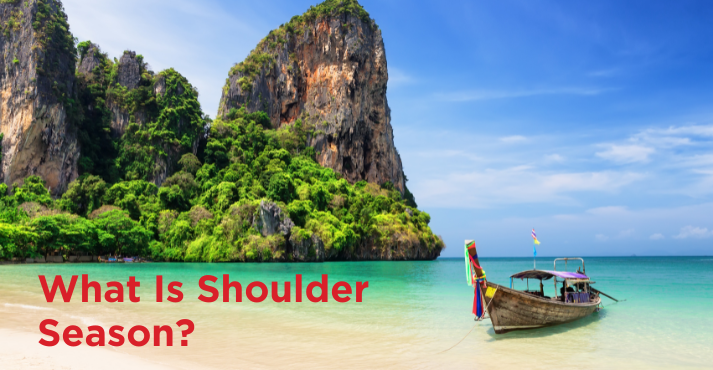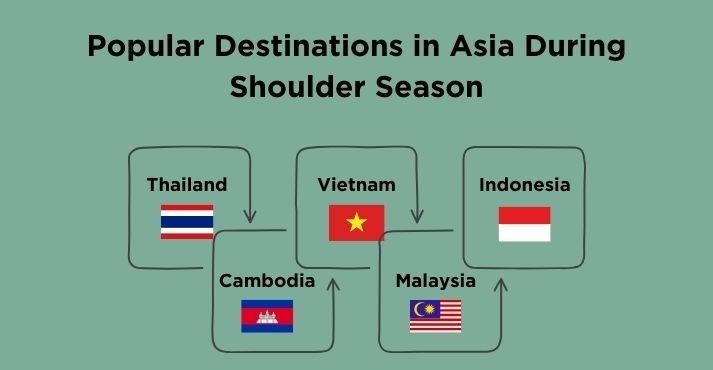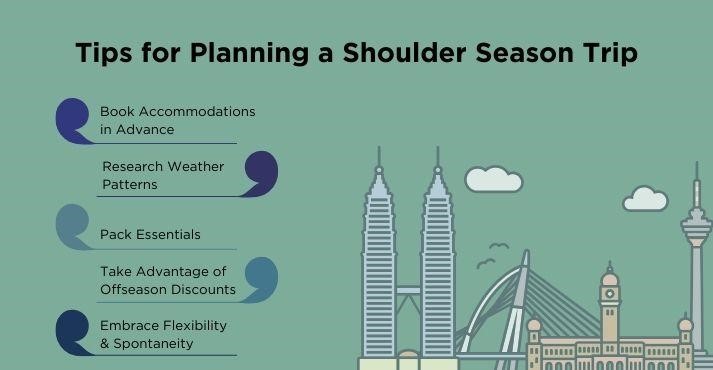When planning a vacation to your favorite destination, you may become irritated by overcrowded destinations and inflated prices.
To resolve the issues, you need to take advantage of the perks offered by shoulder season. But first, we need to understand what shoulder season is.
In the travel industry, shoulder season refers to the peak and off-peak seasons when destinations have fewer visitors.
This period offers travelers the best of both worlds: fewer crowds than peak season but better weather and more amenities than off-peak times.
For Southeast Asian destinations like Thailand, Vietnam, and Indonesia, shoulder season is the perfect solution to avoid the peak season’s scorching heat and heavy rains.
Whether you want to enjoy a relaxing beach picnic or trek through jungles, you must schedule your vacation in the shoulder season to avail yourself of the best perks, amenities, and discounts!
What is Shoulder Season?

Shoulder season is the intermediate period between peak and off-season travel, offering the perfect combination of favorable weather and fewer crowds.
Occurring typically in spring and autumn, this period allows travelers to experience destinations at their best without the hustle and bustle of peak times or the drawbacks of off-peak periods.
In Southeast Asia, shoulder season varies by country. For instance, Thailand often falls between March and May and then again from September to October, presenting an ideal time to explore its beaches and cities without the crowds or monsoon rains.
In Vietnam, shoulder season occurs from April to June and September to November. It is an excellent opportunity to discover its rich culture and stunning landscapes without intense heat or heavy rainfall.
Understanding shoulder season in Southeast Asia helps travelers make the most of their experiences. They can enjoy optimal conditions while avoiding the drawbacks of peak tourist numbers or unfavorable weather during off-peak times.
Why Travel During Shoulder Season?

Traveling during shoulder season in Southeast Asia offers many advantages and perks that cater to every type of traveler.
This time, from budget-conscious backpackers to luxury seekers, provides a perfect mix of affordability, comfort, and cultural experiences.
Lower Prices
The significant dynamic pricing reduction is one of the most appealing aspects of traveling during shoulder season.
From accommodations to transportation and attractions, travelers can enjoy substantial savings compared to peak season rates.
Hotels and resorts often offer discounted prices and special promotions during this quieter period to attract visitors and increase room occupancy rates.
Additionally, airlines may lower their fares to fill empty seats, making flying to and within Southeast Asia more affordable.
Fewer Crowds
With fewer tourists flocking to popular destinations, travelers can explore at their own pace without feeling rushed or overwhelmed by crowds.
This creates a more relaxed and enjoyable experience, allowing visitors to fully immerse themselves in the beauty and culture of Southeast Asia without the distractions of large tour groups.
Pleasant Weather Conditions
Shoulder season occurs in many regions between the peak season’s scorching heat and the off-peak season’s heavy rainfall.
As a result, travelers can expect milder temperatures, lower humidity levels, and fewer extreme weather phenomena like typhoons or monsoons.
Enhanced Cultural Experiences
Traveling during shoulder season provides a unique opportunity to experience Southeast Asia’s local culture and traditions more intimately.
Travelers can interact more authentically with locals, participate in cultural festivals and events, and gain a deeper understanding of the customs and traditions that define each destination.
Whether sampling street food in Bangkok or participating in a temple ceremony in Bali, shoulder season allows for richer cultural immersion and meaningful connections with the communities you visit.
Flexibility and Freedom
Traveling during the shoulder season offers greater flexibility and freedom to explore Southeast Asia on your terms.
With fewer restrictions and less competition for accommodations and activities, travelers can customize their itineraries and indulge in spontaneous adventures.
Whether you’re island hopping in the Philippines or cruising the Mekong River, shoulder season provides the perfect opportunity to discover Southeast Asia’s hidden gems.
Traveling during shoulder season in Southeast Asia offers multiple benefits and opportunities for travelers seeking affordability, comfort, cultural immersion, and adventure.
It is an ideal time to experience the wonders of Southeast Asia without the crowds or constraints of peak season travel.
Popular Destinations in Asia During Shoulder Season

Southeast Asia is home to some of the most stunning destinations that experience shoulder season, offering travelers the perfect opportunity to explore iconic attractions without crowds or inflated prices.
From vibrant cities to tropical islands, here are some popular destinations where travelers can make the most of shoulder season benefits:
Thailand
Known for its pristine beaches, vibrant culture, and bustling cities, Thailand experiences shoulder season from March to May and September to October.
During this time, travelers can enjoy lower prices on accommodations and attractions while still experiencing favorable weather conditions.
Popular destinations such as Bangkok, Chiang Mai, Phuket, and Krabi offer diverse experiences, from exploring ancient temples and bustling markets to indulging in water sports and island hopping in the Andaman Sea.
Vietnam
With shoulder season from April to June and September to November, Vietnam offers travelers the perfect mix of rich history, stunning landscapes, and mouthwatering cuisine.
Explore the charming streets of Hanoi, cruise through the breathtaking limestone karsts of Halong Bay, or immerse yourself in the vibrant culture of Hoi An’s ancient town.
From the bustling streets of Ho Chi Minh City to the serene beauty of Sapa’s rice terraces, Vietnam has something to offer every type of traveler during shoulder season.
Indonesia
Home to some of the world’s most beautiful islands, Indonesia experiences shoulder season from April to June and September to November.
Travelers can escape the crowds and discover hidden gems such as Bali, known for its stunning beaches, lush rice terraces, and vibrant culture.
Explore the temples of Ubud, surf the waves of Kuta, or hike to the summit of Mount Batur for a breathtaking sunrise.
Other popular destinations in Indonesia include the cultural hub of Yogyakarta, the pristine beaches of the Gili Islands, and the volcanic landscapes of Lombok.
Cambodia
Famous for its ancient temples and rich history, Cambodia experiences shoulder season from April to June and September to November.
Explore the temples of Angkor Wat, wander through the streets of Phnom Penh, or relax on the pristine beaches of Sihanoukville.
With fewer tourists, travelers can experience the magic of Cambodia’s cultural and natural wonders in a more intimate setting.
Malaysia
With shoulder season from March to May and September to November, Malaysia offers travelers diverse experiences, from bustling cities to pristine beaches and lush rainforests.
Explore the streets of Kuala Lumpur, visit the historic city of Malacca, or trek through the jungles of Taman Negara National Park.
Other popular destinations include the idyllic islands of Langkawi and Penang, where travelers can relax on white sandy beaches and indulge in mouthwatering cuisine.
Tips for Planning a Shoulder Season Trip

Planning a trip during the shoulder season in Southeast Asia can be an excellent way to experience popular destinations without crowds or high prices.
Here are some practical tips and advice to help you make the most of your shoulder season adventure:
Book Accommodations in Advance
While shoulder season offers lower prices and fewer crowds, booking accommodations in advance is essential, especially if traveling to popular tourist destinations.
Many hotels and resorts offer early booking discounts, so secure your accommodations ahead of time to avoid last-minute price hikes or limited availability.
Research Weather Patterns
Before you pack your bags, research the weather patterns of your chosen destination during shoulder season.
While shoulder season generally offers pleasant weather conditions, some regions may still experience occasional rainfall or humidity.
Pack with lightweight clothing, a waterproof jacket, and sturdy walking shoes to ensure you’re prepared for any weather conditions.
Pack Essentials
Remember to include sunscreen, insect repellent, a reusable water bottle, and any necessary medications when packing for your shoulder-season trip to Southeast Asia.
Additionally, consider bringing a lightweight travel umbrella or poncho for unexpected rain showers and a power adapter and portable charger to keep your devices powered up while on the go.
Take Advantage of Offseason Discounts
One of the biggest perks of traveling during shoulder season is taking advantage of off-season discounts on flights, accommodations, and attractions.
Keep an eye out for special promotions and deals offered by airlines, hotels, and tour operators, which can help you save even more money on your trip.
Additionally, consider purchasing attraction tickets in advance or booking guided tours to secure discounted rates and skip the lines at popular tourist sites.
Embrace Flexibility and Spontaneity
Lastly, embrace the spirit of flexibility and spontaneity during your shoulder season trip to Southeast Asia.
While it’s essential to have a general itinerary in mind, be open to unexpected opportunities and experiences that may arise along the way.
Whether stumbling upon a hidden gem or joining a local festival or event, allowing yourself to go with the flow can lead to unforgettable moments and memories.
Following these practical tips and advice, you can plan a memorable and enjoyable trip to Southeast Asia during shoulder season, taking advantage of lower prices, fewer crowds, and pleasant weather conditions to create unforgettable travel experiences.
Activities and Attractions to Enjoy During Shoulder Season
Shoulder season in Southeast Asia offers travelers the perfect opportunity to explore various activities and attractions, from cultural festivals to outdoor adventures and culinary experiences.
Here are some recommendations for things to do during shoulder season travel:
Cultural Festivals
Experience the vibrant culture of Southeast Asia by attending local festivals and events during shoulder season. In Thailand, the Songkran Festival (Thai New Year) is celebrated nationwide in April, with water fights and traditional ceremonies.
In Vietnam, the Hue Festival showcases the rich heritage and traditions of the ancient capital city through music, dance, and art performances in April.
Additionally, the Bali Arts Festival in June and July offers visitors the chance to witness traditional Balinese dance, music, and crafts.
Outdoor Adventures
Explore the natural beauty of Southeast Asia through outdoor adventures during shoulder season.
Go trekking in the jungles of Borneo to spot orangutans and other wildlife, or hike to the summit of Mount Kinabalu for breathtaking views of the surrounding landscapes.
In Laos, kayak along the Mekong River to discover remote villages and stunning scenery, or embark on a cycling tour through the countryside of Luang Prabang.
Snorkeling and diving in the crystal-clear waters of the Philippines or Indonesia offer unforgettable underwater experiences for water enthusiasts.
Culinary Experiences
During shoulder season, indulge in Southeast Asia’s diverse and delicious cuisine by exploring local markets, street food stalls, and traditional restaurants.
Sample authentic Thai dishes such as pad Thai, green curry, and mango sticky rice in Bangkok’s bustling food markets, or savor fresh seafood and tropical fruits in the coastal towns of Vietnam.
In Malaysia, taste the unique flavors of Nyonya cuisine in Penang or feast on spicy laksa and nasi lemak in Kuala Lumpur’s vibrant neighborhoods.
Off-the-Beaten-Path Discoveries
Venture off the beaten path to discover hidden gems and lesser-known attractions during shoulder season travel.
Explore the ancient ruins of Angkor Wat in Cambodia, where you can wander through intricately carved temples and watch the sunrise over the majestic complex.
In Myanmar, visit the ancient city of Bagan to marvel at thousands of ancient pagodas and stupas scattered across the landscape.
Alternatively, take a boat trip through the floating markets and villages of the Mekong Delta in Vietnam or hike to remote hill tribe villages in northern Thailand for a glimpse into traditional rural life.
From cultural festivals and outdoor adventures to culinary experiences and off-the-beaten-path discoveries, shoulder season in Southeast Asia offers travelers a wealth of opportunities to explore and experience the rich diversity and beauty of the region.
Challenges and Considerations
Weather Variability
While shoulder season travel has advantages, it’s crucial to address potential challenges related to weather variability. Being prepared for unexpected climate changes ensures a smoother journey.
Let’s explore how travelers can navigate the nuances of weather challenges during the shoulder season.
1. Adaptable Travel Planning:
- Check Regional Climate Patterns: Different regions experience shoulder seasons at varying times. Before your trip, research the typical weather patterns of your destination during the shoulder season. This knowledge allows for more informed and adaptable travel planning.
- Pack Versatile Clothing: Given the potential for weather fluctuations, pack versatile clothing that can be easily layered or removed. This ensures that you’re prepared for both cooler mornings and warmer afternoons.
2. Weather-Resilient Itineraries:
- Have a Flexible Itinerary: Unpredictable weather may necessitate changes to your planned activities. Design your itinerary flexibly, allowing adjustments based on the day’s weather conditions.
- Plan Indoor and Outdoor Activities: Mix indoor and outdoor activities in your daily plans. This way, you can seamlessly shift between exploring outdoor attractions when the weather is favorable and enjoying indoor experiences during inclement weather.
3. Navigating Weather Variability in Shoulder Season:
- Monitor Weather Forecasts: Stay informed about your destination’s daily and weekly weather forecasts. Apps and websites can provide real-time updates, helping you make timely activity decisions.
- Carry Weather-Appropriate Gear: Be prepared for different weather scenarios by carrying essential gear such as a light waterproof jacket, a travel-sized umbrella, and sturdy walking shoes. This ensures you’re ready for unexpected changes.
4. Staying Prepared for Changing Climates:
- Stay Hydrated and Protected: In warmer climates, staying hydrated is crucial. In cooler climates, ensure you have adequate protection against the cold. Be proactive in adjusting your clothing and habits to match the prevailing weather.
- Have a Plan B for Outdoor Activities: If your itinerary includes outdoor excursions, have a backup plan for days when the weather might not cooperate. This could involve alternative indoor activities or rescheduling outdoor adventures for a more straightforward day.
Limited Availability for Specific Activities
While shoulder season travel offers many benefits, it’s essential to address the potential challenge of limited availability for specific activities or attractions.
Awareness of seasonal constraints and planning accordingly is vital to maximizing your journey. Let’s explore the considerations for navigating limited availability during the shoulder season.
1. Strategic Activity Scheduling:
- Research Seasonal Closures: Some attractions or activities may experience seasonal closures or limited operation during the shoulder season. Before finalizing your itinerary, research and identify any places that might be closed or have restricted access during your travel dates.
- Prioritize Must-See Activities: If some specific activities or attractions are a must-see for you, prioritize them in your schedule. Check their operating hours and days to ensure you take advantage of critical experiences.
2. Planning Around Seasonal Constraints:
- Be Flexible with Timing: In some cases, certain activities may have limited availability on specific days or times. Be flexible with your schedule, and plan to engage in these activities during their designated operating hours.
- Consider Alternative Options: If a preferred activity is unavailable during your visit, consider backup options or alternative experiences. This proactive approach ensures you can maximize your time, even if certain activities have limitations.
3. Addressing Limited Availability in Shoulder Season:
- Book in Advance: Consider booking in advance for activities with limited availability. This is especially important for popular tours, events, or attractions that may have a restricted number of participants. Securing your spot early ensures you will get all the benefits.
- Check Seasonal Events Calendar: Many destinations host seasonal events and festivals. Check the local events calendar for any noteworthy happenings during your visit. Attending these events can be a unique way to experience the destination, even if some regular activities are limited.
4. Planning Around Seasonal Activity Constraints:
- Utilize Local Advice: Seek advice from locals or travel experts about potential limitations during the shoulder season. Locals often have valuable insights into which activities or attractions may be affected and can provide recommendations for alternative options.
- Stay Informed About Restrictions: Stay updated on any seasonal restrictions imposed by authorities or attractions. Changes in COVID-19 protocols, weather-related closures, or other factors may impact the availability of certain activities, so staying informed is crucial.
Shoulder Season (FAQs)
What is the shoulder season period?
The shoulder season is the transitional period between peak and off-peak travel seasons. It is characterized by moderate weather and fewer tourists.
Typically occurring in spring and autumn, it offers travelers the chance to enjoy destinations with reduced crowds and often lower prices.
Which month is best to visit Singapore?
During the dry season, the best month to visit Singapore is generally between February and April.
This period offers sunny weather with less rainfall and lower humidity, making it ideal for exploring the city’s attractions, gardens, and outdoor activities.
What is a shoulder night in a hotel?
A shoulder night typically in a full-service hotel refers to a night that falls between peak and off-peak seasons, typically characterized by lower demand and potentially lower rates.
It’s a transitional period where hotels may offer special promotions or discounts to attract guests during this quieter time.
Conclusion
This blog focuses on understanding shoulder season, helping you plan your trip beforehand and enjoy all the destination perks at a significantly lower cost.
Exploring Southeast Asia during the shoulder season offers an exciting opportunity for travelers to experience affordability, comfort, and cultural immersion.
With lower prices, fewer crowds, and pleasant weather conditions, this hotel marketing strategy attracts visitors to experience popular destinations without the drawbacks of peak tourist numbers or unfavorable weather.
From attending cultural festivals to exploring outdoor adventures and culinary delights, shoulder season offers many activities and attractions to suit every traveler’s interests.
By planning ahead, travelers can make the most of their shoulder season journeys and create unforgettable memories of their trips to Southeast Asia!















